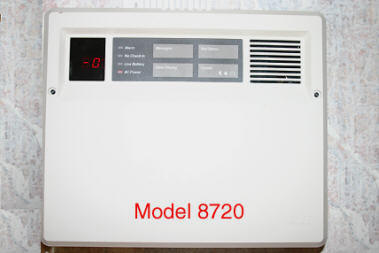
Shared Knowledge
"AT&T Home Security System"
"Causes of No-Check-in's"
19 April 2007

AT&T Home Security System universal transmitters and smoke detectors emit a radio frequency (RF) signal that is received by the central controller (CC). The CC does not radiate any RF signal. The frequency of the system is in the 40MHZ band.
The best case scenario for the CC to receive a very strong signal from any A&T Home Security System device, is for all devices to have a fresh 9 volt battery, the CC to have a antenna of 10 or more feet in length, for the CC to be centrally located in the house such that all system devices are about equal distance from the CC, for there to be no floors or walls between the CC and all transmitters and there be no metal anywhere in the area of any transmitter or the CC.
If the above defines the best case scenario, most installations are somewhat less than ideal or perfect.
- Walls and floors. In most all homes, there are walls and in some cases, like mine, several floors. Walls and floors reduce the signal received by the CC from the ideal or perfect. For years, my system was stable but then I began getting "no check-in's" from one universal transmitter. Turned out that I had recently floored my attic and the wood in the flooring was enough to weaken the signal from one universal transmitter.
- Length of the CC antenna and location. In the AT&T Home Security System, the power cord between the CC and the power line adapter serves as the CC's antenna. When my system was installed, the length of the antenna was about 6 or 7 feet although I suspect in many installations, the length of the power cord is even shorter than 6 feet. Basically, the shorter the antenna, the less signal received by the CC. In addition to length, there is also the location of the CC antenna to consider. If the CC is located at one end of the house, considering walls and floors, the signal received by the CC from one or more universal transmitters might be less than it could be if the antenna was longer or the CC centrally located. In my case, from the original installation, I have moved the CC and its antenna from a basement utility room to a central location on the top floor with a 50 foot antenna in the attic.
-Battery voltage. As defined the the perfect scenario, every AT&T Home Security System transmitting device is going to have the strongest signal, right at the device, when the battery installed is fresh or reads 9 or slightly more volts, via a voltmeter. But as every day goes by, the battery begins to loose voltage and thus the transmitter emits a weaker and weaker signal. According to AT&T literature, a properly installed system should not register "no check-in's" for one year after fresh battery replacement. After some system rework, such as moving the CC to a location central in my home and extending the antenna, I now get 1 year on a battery change. When I do change batteries, most batteries read about 7.5 to 8 volts. Now, I change all batteries in my system in or around 1 January each year.
- Metal in or around a system device. It has been my experience that metal in the general vicinity of a universal transmitter can significant affect it RF signal. Where I have noticed this is when my system has been stable for years and suddenly I start getting a "no check-in" on one particular transmitter. In one case, a metal flower planter had been placed in front of the a universal transmitter, right in the line of sight between the transmitter and the CC. In another case, a large metal plate attached to a wood sculpture was enough to cause a "no check-in."
If any or all of the above can cause "no check-in's", cordless phones, cell phones, microwaves, and computer WIFI can not as all these operate in a completely different RF band. And as for a defective universal transmitter, I have never had one. I have thought I had one, more than once and actually swapped out a suspect for a spare I had but the suspect was not bad. Universal transmitters are just such a simple devices that the likelihood that you have once is pretty small.
Click here for more AT&T Home Security System.